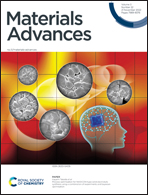Switching endurance of the molecular spin crossover complex [Fe(HB(tz)3)2]: from single crystals to thin films and electronic devices
Abstract
The spin-state switching stability of the benchmark [Fe(HB(tz)3)2] (tz = 1,2,4-triazol-1-yl) complex is examined in single crystals, thin films and ITO/[Fe(HB(tz)3)2]/Al metal–insulator–metal junctions. In each case, the switching behavior remains virtually unaltered for more than 10 000 endurance cycles in ambient air, even after more than one-year storage time. The structural/morphological integrity of the samples is not affected to any appreciable extent. On the other hand, the junctions exhibit a slow decrease of their conductance. Based on a comparison with analogous ITO/[Zn(HB(tz)3)2]/Al junctions, we attribute this phenomenon to the degradation of the device itself, rather than to the deterioration of the SCO properties. These results highlight the intrinsic stability of certain spin crossover compounds, providing impetus for future work, aiming at both the fundamental understanding of this switching stability and its exploitation in technological applications.
![Graphical abstract: Switching endurance of the molecular spin crossover complex [Fe(HB(tz)3)2]: from single crystals to thin films and electronic devices](/en/Image/Get?imageInfo.ImageType=GA&imageInfo.ImageIdentifier.ManuscriptID=D2MA00802E&imageInfo.ImageIdentifier.Year=2022)


 Please wait while we load your content...
Please wait while we load your content...